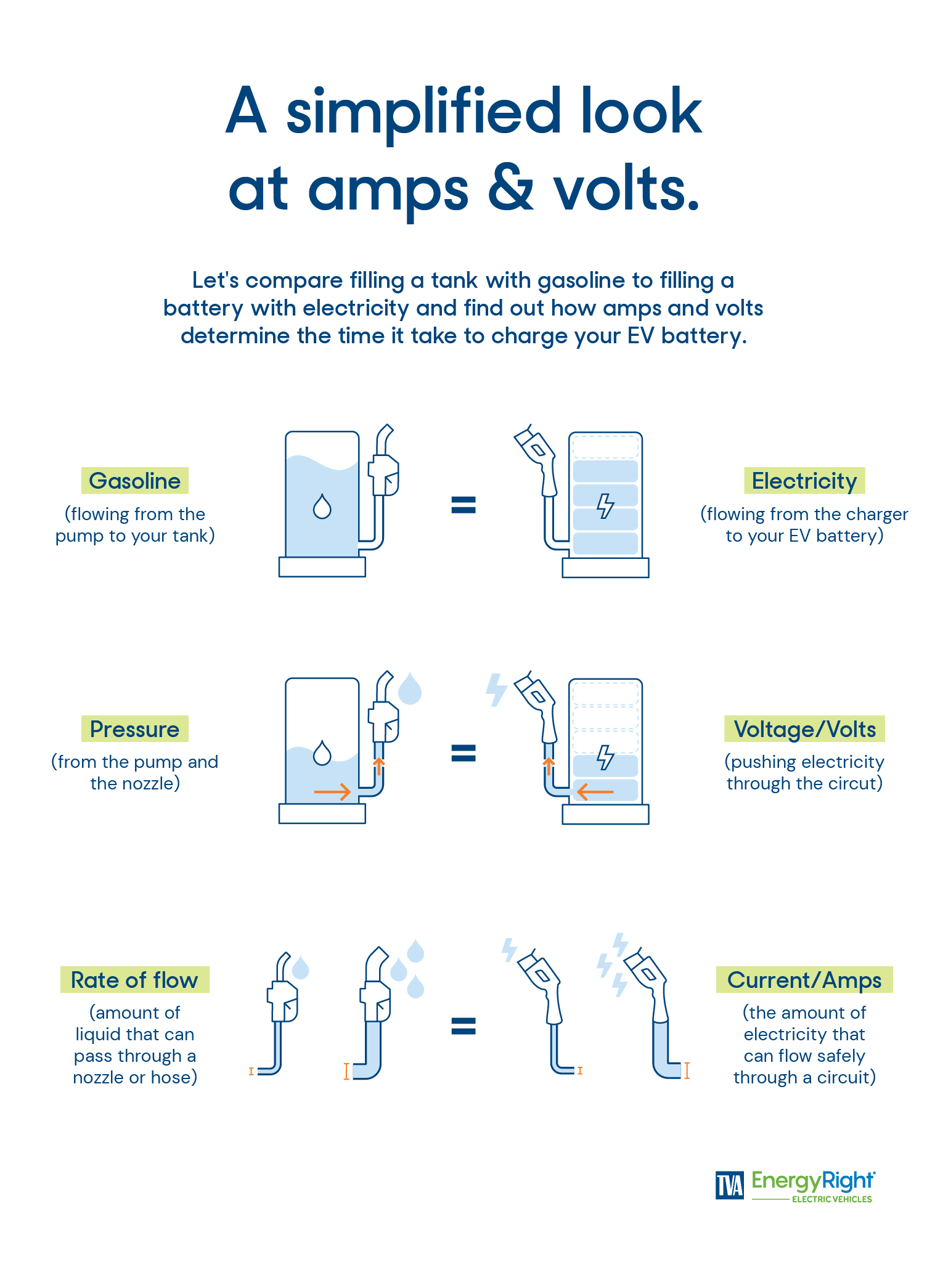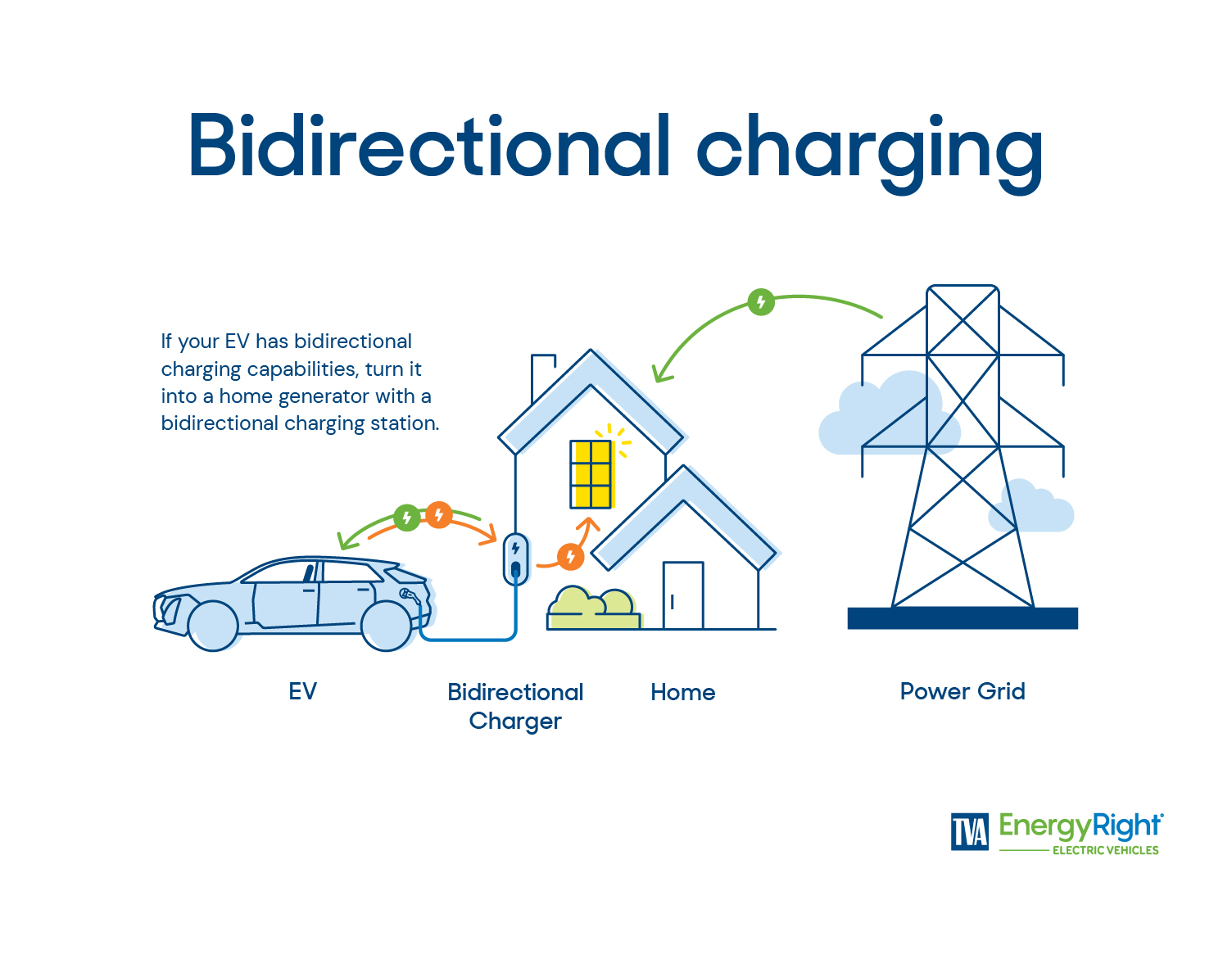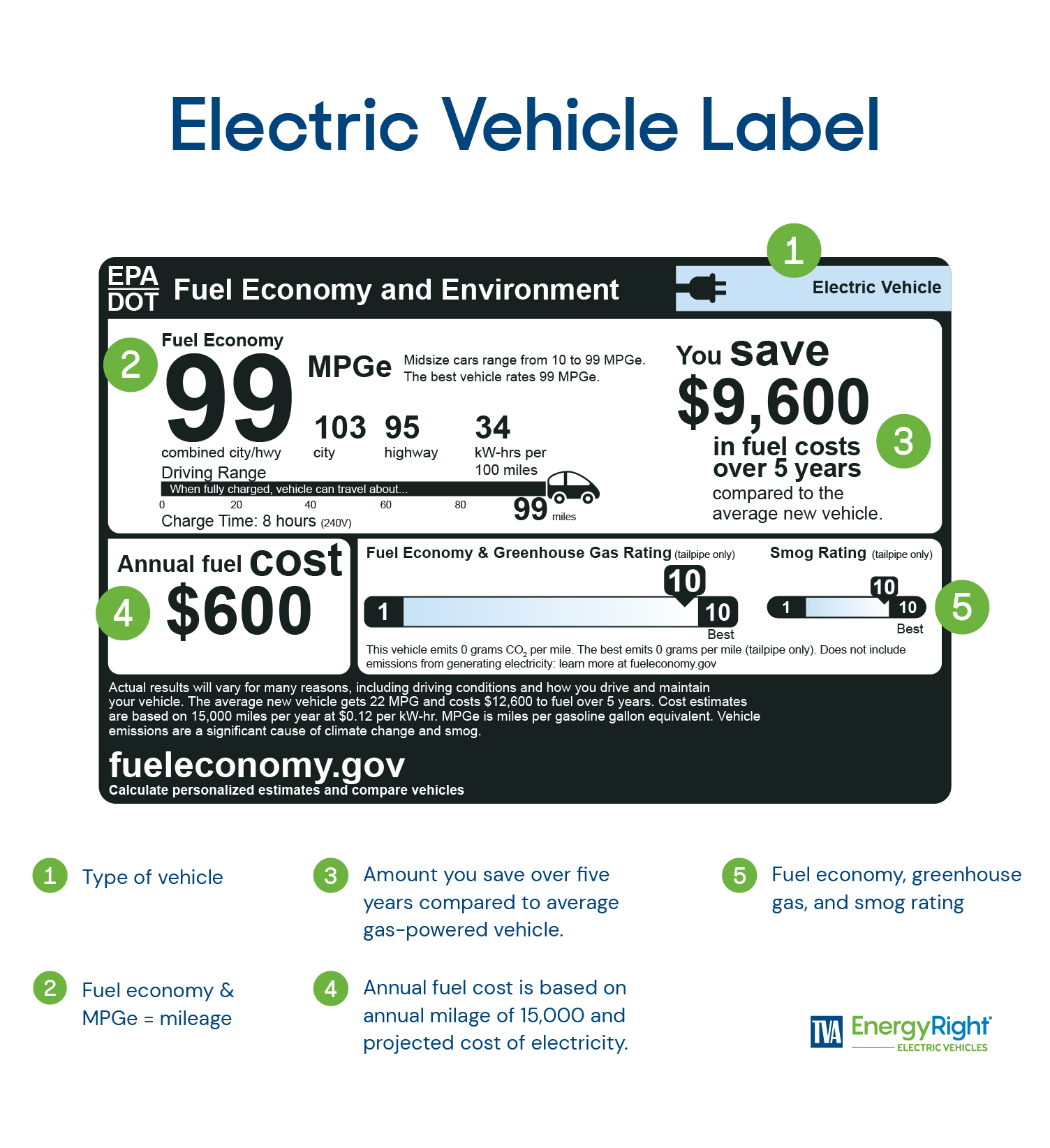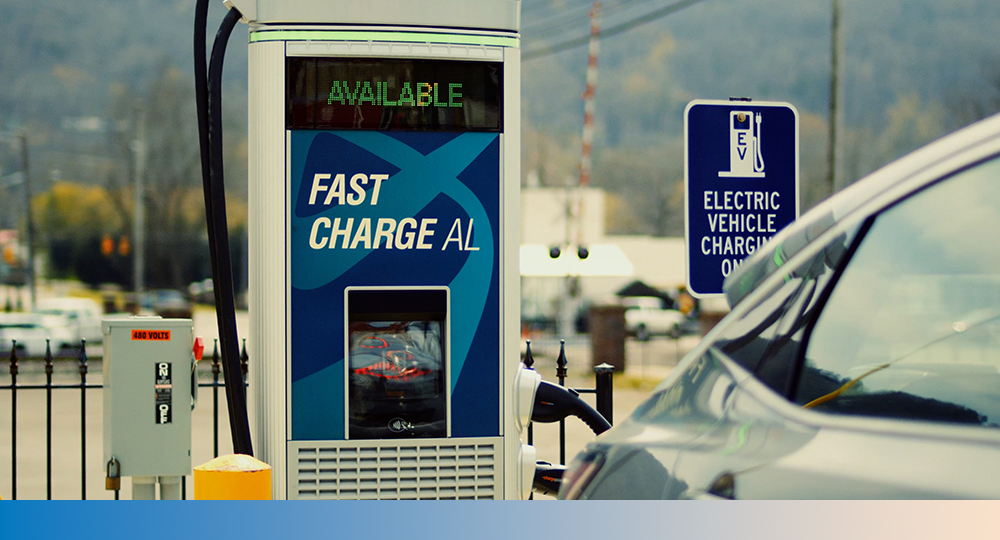From Amps to ZEV: Electric Vehicle terms you need to know.

TVA EnergyRight presents your Ultimate Electric Vehicle Glossary: Electric Vehicle terms and lingo defined.
Keeping up with the latest electric vehicle terms, topics and trends can seem like a pretty daunting task. Luckily for you, we’re plugged into the electric transportation scene and we’re amped to share our Ultimate Electric Vehicle Glossary with you.
If electricity moves it, we’re ready to fuel it.
Our EV team has been on the road a lot over the past few months, visiting with people from all over our seven-state Valley region and sharing information about EVs.
We’ve chatted with drivers who are thinking about buying an electric car because they want to save money on gas. Others want to reduce their carbon footprint with a zero-emissions vehicle. Many enjoy the cool tech while plenty of others appreciate how quick they are.
We’ve also met commuters who want to get a little more exercise on their way to work and are considering an electric bicycle. We’ve even chatted about electric forklifts with business owners looking to provide a quieter, safer work environment for their employees while lowering emissions.
The Ultimate Electric Vehicle Glossary
This glossary is dedicated to all the great people we’ve met and all of the wonderful questions they asked about EV terms, technology and breaking news.
All-electric range (AER): The driving range of a vehicle using only power from its battery pack. Also known as range per charge.
Alternating current (AC): A term that describes the flow of electricity. In the U.S. the direction of the current changes (alternates) direction every 60 seconds (energy.gov). AC powers Level 1 and Level 2 EV chargers. (See “Battery Basics.”)

Amps (A): Also known as amperes, is a unit of measure for electrical current flow. An EV’s amp rating (or the charging station’s amp rating) is one factor that determines the maximum amount of power that can be delivered to your car’s battery. If voltage is to electricity as pressure at the gas pump is to gasoline, then amps x volts = watts all work together to measure how quickly you can fill up your battery with power.
Battery cell: The smallest unit in an EV’s battery pack. Think of it like a gallon of gas.
Battery electric vehicle (BEV): An EV that relies entirely on electric power stored in its battery pack. (See “The EV alphabet.”)
Battery module: A group of battery cells bundled together. Think of it as a few gallons of gas.
Battery management system: This system makes sure that the battery pack is operating at ideal temperatures. This helps prolong battery life and improve charging speed.
Battery pack: An EV’s battery is where the electricity that powers your car is stored. Think of it as the fuel in your EV’s “tank.”

Bidirectional charging: A technology that allows energy to flow two ways: from the electricity grid to your EV, and from your bidirectional EV charger to the grid. See vehicle to grid (V2G) (future state) and vehicle to home (V2H) (select EVs and charger stations).

Capacitor: A temporary power storage module in an electrical circuit that helps regulate spikes in power.
Charging: Fueling your EV with electricity.
Charging station: See electric vehicle supply equipment (EVSE).
Combined charging system (CCS): A standard for charging electric vehicles that can accommodate Type 1 and Type 2 AC charging and DC fast charging because it also includes a J1772 outlet. (See “Charging 101.”)
Connector: A general EV term that includes a variety of standardized plugs used to charge electric vehicles. It may include the Type 1 J1772, CCS and NACS connections.
Direct current (DC): A current that provides constant voltage and the current flows in one direction. It doesn’t change or vary over time. DC powers EV fast chargers because the direct flow of current – delivered directly to the battery – can charge more quickly. (See “Battery Basics.”)

Drag coefficient (Cd): A measurement of a vehicle’s wind resistance. The higher the drag coefficient, the harder the motor has to work to push your EV through the air. The lower the drag coefficient, the better!
Dynamic electric vehicle charging (DEVC): This future-state method of wireless charging is being tested and would enable EVs to recharge while driving on public roads (MotorTrend).
Electric vehicle (EV): Any vehicle, whether it’s a car, bicycle, boat, forklift, or scooter, that’s powered by electricity stored in batteries.
Electric vehicle supply equipment (EVSE): What you’ll need to safely charge your EV at home. It includes the cables, connectors and charging points. (See “Charging 101.”)
Fast Charge Network: TVA EnergyRight is collaborating with state agencies, local power companies and third-party charging developers to develop the Fast Charge Network, which will place fast charging stations at least every 50 miles along major travel corridors in the seven-state region.
Fast charging: Also known as Level 3 charging, it refers to the number of watts (W) that are delivered to an EV’s battery. Most fast chargers are direct current (DC) and deliver over 19 kilowatts (kW). These chargers and superchargers are most commonly found at shopping centers, travel centers, dealerships and other public locations.
Frunk: It’s that space in the front where the engine lives in gas-powered vehicles. We recommend putting your junk in it.
Fuel cell electric vehicle (FCEV): A vehicle that uses a fuel cell, usually hydrogen-based, to generate electricity that runs an onboard motor. (See “The EV alphabet.”)
Home charging: Approximately 80% of EV charging is done at home. Home charging systems – EVSEs – enable EV owners to charge up at home. It’s just as convenient as plugging in your cell phone overnight (Energy.gov).
Hybrid electric vehicle (HEV): Also known as “conventional,” “self-charging” or “mild” hybrids, these EVs use gas-fueled ICE engines and electricity-fueled motors. Hybrid vehicles — like the Toyota Prius or Honda CRV — use regenerative braking to store energy and typically have a smaller all-electric range (see “The EV alphabet”).
Incentives: You may be eligible for federal tax credits on qualified plug-in electric vehicles. Learn more about credits for clean vehicles purchased in 2023 or after at IRS.gov.
Internal combustion engine (ICE): A heat engine that converts energy from the heat of burning gasoline into torque that powers the vehicle (Car and Driver).
Inverter: An electrical device that converts electricity from a DC source to AC.
J1172: Also known as a J plug or SAE J1772, a North American standard for electrical connectors for EVs.
Kilowatt (kW): Equivalent to 1,000 watts, a unit of measure for power. Power tells us how fast energy is moving at any moment in time. (See “Battery Basics.”)
Kilowatt-hour (kWh): How many watts are consumed in an hour. (See “Battery Basics.”)
Level 1 Charging: Also known as “slow chargers” or “trickle chargers,” Level 1 chargers can plug into any standard 120-volt home wall outlet, the very same type of outlet you use to plug in your cell phone or coffee pot.
Level 2 Charging: These 240-volt chargers are just like the ones your dryer plugs into and can charge a BEV in 4-10 hours, which makes them perfect for overnight home charging.
Level 3 Charging: See fast charging.
Lithium-ion: A rechargeable battery that uses lithium ions to store energy (MIT.edu).
Miles per gallon equivalent (MPGe): An energy-efficiency metric introduced by the Environmental Protection Agency (EPA) to compare the amount of energy consumed by alternative fuel vehicles to gas-powered cars (U.S. News & World Report).
Miles per kilowatt hour (mpkWh): A measurement of an EV’s efficiency that demonstrates how an EV’s power output translates into real distance traveled.

North American Charging Standard (NACS): Previously known as the Tesla charging connector, this charging standard is used in Tesla’s Supercharger network. Ford and General Motors announced in June 2023 that their drivers will be able to charge their cars (with an adapter) at Tesla charging stations across the country. Less than a month later, seven of the world’s largest automakers announced that they’re building a new nationwide network of 30,000 electric vehicle charging stations (CBS News).
Off-peak charging: Charging your EV at times when demand for electricity is lower (typically overnight) helps maintain a healthy grid and keeps rates low for everyone.
On-board charger (OBC): A device that converts AC to DC to charge an EV’s batteries. Fast chargers bypass an EV’s OBC because they’re already DC.
Parallel hybrid: Vehicles with a parallel hybrid drive enable the engine and electric motor to work together to generate power to drive the wheels.
Plug-in hybrid electric vehicle (PHEV): A plug-in vehicle featuring a rechargeable battery, electric propulsion and regenerative braking. PHEVs also rely on a gas-powered internal combustion engine (ICE) for propulsion once the battery is depleted. (See “The EV alphabet.”)
Regenerative braking: Also known as “regen braking,” these systems are unique to EVs. They turn a vehicle’s kinetic energy (energy that relates to motion) back into electric energy. Regenerative braking helps improve fuel efficiency, reduce total tailpipe emissions and minimizes wear and tear on brakes. (See “Battery Basics.”)
Renewable energy: Energy that is generated by natural resources that are replenished faster than they are consumed such as solar, hydroelectric, and wind. Nearly 60% of TVA’s electricity comes from carbon-free sources (TVA.com).
Residential charging: See home charging.
Solid-state battery: Like lithium-ion batteries, solid-state batteries store energy; however, instead of an organic liquid electrolyte solution sandwiched between the cathodes and anodes, solid-state batteries use solid electrolytes. Some manufacturers are planning to roll them out as early as 2027. Solid-state batteries offer higher energy density, greatly extended range and faster charging times.

State of charge (SOC): The level of charge an EV battery contains compared to its capacity. 0% SOC = empty; 100% SOC = full.
Supercharger: A kind of EV charger developed by Tesla designed for fast charging.
Torque: A force that produces rotation. Motors deliver torque to the drive shaft (Merriam-Webster). Electric cars achieve maximum torque immediately and deliver instant torque to the vehicle’s wheels, which leads to excellent acceleration off the line (or from a red light).
Vehicle to grid (V2G): Power that flows from your vehicle back to the grid. This future-state capability has the potential to support the power grid during peak demand hours. (See Bidirectional charging.)
Vehicle to home (V2H): Power that flows from your EV to your home, essentially acting as a generator during weather-related power outages. (See Bidirectional charging.)
Volts (V): A unit of electrical force that measures the amount of effort required to move an ampere between two points. A higher voltage rating on a charging station equals a higher charging speed for your EV. Volts x Amps = Watts (See Amps).
Watts (W): A unit of measure for power. Power tells us how fast energy is moving at any moment in time. A kWh tells you how many of those units are consumed in an hour. Volts x Amps = Watts (See Amps).
Zero emission vehicle (ZEV): A vehicle that emits no tailpipe pollutants during operation. Battery electric cars, bicycles, motorcycles and hydrogen fuel cell vehicles are examples of ZEVs.
We know that big changes – like purchasing a vehicle that runs on electricity instead of gasoline – can lead to big questions. And that’s why we’re doing our best to provide expert, unbiased answers to your pressing EV questions. Each of our posts will include links to trusted external sources like automotive magazines, thought leaders, research-backed studies, government agencies and more. Feel free to click around!
This site’s content (including, without limitation, references and links to third-party information) is based on information provided at the time of publishing, and TVA makes no warranty therein.



